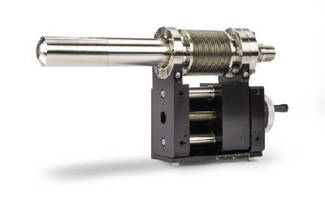Cylindrical Mirror Analyzer supports AES technique.
Press Release Summary:

Used in Auger Electron Spectroscopy or surface analysis technique, microCMA™ analyzes top-most atomic layers of materials. Instrument measures kinetic energies of electrons emitted from materials in vacuum chamber. By installing analyzer onto small open port on analytical vacuum chambers, need for additional vacuum hardware is eliminated. Product is suited for research areas such as Thermal Desorbed Spectroscopy and Atomic Layer Deposition.
Original Press Release:
RBD Instruments Unveils New Analyzer for Auger Electron Spectroscopy (AES) Technique, Makes AES More Practical and Affordable for Researchers and Scientists
BEND, Ore., – RBD Instruments, Inc., announced the release of its latest instrument for analyzing the top-most atomic layers of materials, the microCMA™. "We are very excited to bring this new product to the surface analysis market. It will be an invaluable tool for researchers and scientists at universities and research facilities world-wide," says Randy Dellwo, President of RBD.
The microCMA is a compact cylindrical mirror analyzer (CMA) that measures the kinetic energies of electrons emitted from materials in a vacuum chamber. This type of analyzer is used in the Auger Electron Spectroscopy (or AES) surface analysis technique, which is named after the French physicist Pierre Auger who co-discovered the effect in the 1920s.
In use since the 1950s, AES has become a practical characterization technique in research areas such as surface chemistry and thin films. The first commercial Auger electron spectrometers were introduced in the early 1960s and since that time, they have improved in performance, increased in size, and today can cost well over 1 million USD. RBD's microCMA provides high performance in a small form factor for a tiny fraction of what larger cylindrical mirror analyzers cost.
"Our microCMA is a real game changer in the world of thin film surface analysis," Dellwo explained. Many analytical vacuum chambers have a small open port where the microCMA could be added. Installing a microCMA onto such an existing vacuum chamber can be an ideal way to add the AES surface analysis technique, while eliminating the need for additional vacuum hardware.
By making the CMA smaller, the vacuum chamber and pumping requirements are also reduced, which all help make AES much more affordable to researchers. Smaller vacuum chambers and pumps reduce the overall cost of a vacuum system by a significant amount.
The small size of the microCMA also makes AES practical as an analytical technique for small vacuum chambers used in research areas such as Thermal Desorbed Spectroscopy and Atomic Layer Deposition.
For more information visit the RBD Instruments Inc. website at www.rbdinstruments.com or call Mindy Corley at 541-550-5016.




